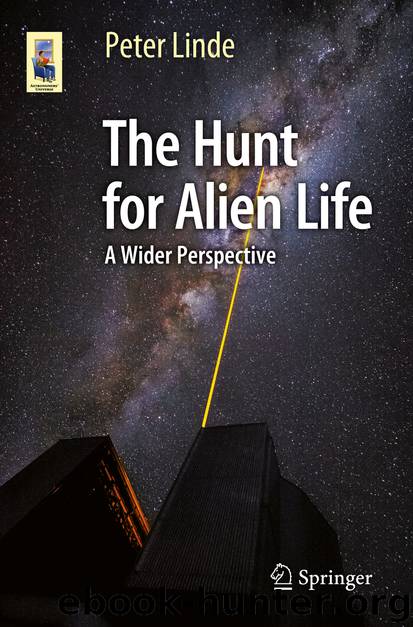The Hunt for Alien Life by Peter Linde

Author:Peter Linde
Language: eng
Format: epub
Publisher: Springer International Publishing, Cham
Vision for the Future: An Interstellar Radar
We have seen how astronomical observations are all about finding ways to carefully, patiently and shrewdly collect light that has been on its way towards Earth for many years. Within the solar system we have the opportunity to do in situ observations by sending space probes or even manned space flights. To physically visit exoplanets is, however, currently clearly impossible, even though we will look more closely at such ideas in Chap. 12. But there may be yet another possibility, namely to actively study exoplanets with radar. Radar studies of objects in the solar system have already been carried out for decades. By transmitting radar pulses in different ways to study their reflection, it is possible to obtain detailed information. Radar echoes have been successfully received from as far as the rings of Saturn and its moon Titan .
The American scientist and electronics expert Louis K. Scheffer recently presented the concept of building an interstellar radar system. He believed that this technology is within reach now, both technically and economically. The problem is that interesting distances (10–15 light years) are about 100,000 times longer than distances to Titan , so such a system needs to have gigantic dimensions. Scheffer estimates that an area the size of Hawaii (10,000 km2) would need to be filled with receiving dishes, and an area about ten times larger (about the size of Iceland) would be needed for the transmitting portion. Suitable isolated and radio quiet areas can be found in the inner parts of Australia or in Africa. Scheffer estimates that the energy needed for the transmission, about 10 Terawatts—corresponding to about the output of 10,000 nuclear power plants—is already available since locally infalling solar energy could be used. He estimates the cost of such an undertaking constructed during a time period of twenty years would be comparable to military spending during the same period.
With interstellar radar it becomes possible to study in detail hundreds of exoplanets within the nearest twenty light years. Naturally, one would need to wait for twice the corresponding time to get any results but this is significantly faster than an interstellar expedition would require. In any case, such a radar system would pave the road for future in situ studies.
Download
This site does not store any files on its server. We only index and link to content provided by other sites. Please contact the content providers to delete copyright contents if any and email us, we'll remove relevant links or contents immediately.
Tools of Titans by Timothy Ferriss(7811)
Turbulence by E. J. Noyes(7700)
Astrophysics for People in a Hurry by Neil DeGrasse Tyson(5000)
Secrets of Antigravity Propulsion: Tesla, UFOs, and Classified Aerospace Technology by Ph.D. Paul A. Laviolette(4990)
Design of Trajectory Optimization Approach for Space Maneuver Vehicle Skip Entry Problems by Runqi Chai & Al Savvaris & Antonios Tsourdos & Senchun Chai(4839)
Room 212 by Kate Stewart(4732)
Pale Blue Dot by Carl Sagan(4613)
The David Icke Guide to the Global Conspiracy (and how to end it) by David Icke(4377)
A Journey Through Divination and Astronomy by Publishing Pottermore(4248)
Apollo 8 by Jeffrey Kluger(3512)
Goodbye Paradise(3444)
Losing the Nobel Prize by Brian Keating(3425)
COSMOS by Carl Sagan(3346)
The Five People You Meet in Heaven by Mitch Albom(3334)
How to Read Water: Clues and Patterns from Puddles to the Sea (Natural Navigation) by Tristan Gooley(3239)
Brief Answers to the Big Questions by Stephen Hawking(3239)
How to Read Nature by Tristan Gooley(3077)
The Order of Time by Carlo Rovelli(3073)
A Brief History of Time by Stephen Hawking(2819)
